Abstract
While the evidence for a clustering of health habits is not particularly strong, there are both pedagogic and economic arguments in favour of a multifaceted approach to health education. The present review thus examines the impact of regular physical exercise upon other forms of health behaviour, testing the extent to which an activity programme can be a catalyst of improved lifestyle in both primary and secondary preventive therapy. The conceptual framework of health promotion is examined with particular reference to the models of Skinner, Becker, Fishbein, Triandis and Rokeach. Certain differences are noted between the decision to exercise and the marketing decisions for which Fishbein's model was originally designed. Nevertheless, in its later modifications, it provides a basic framework for understanding how human lifestyle is shaped. Theoretical mechanisms are suggested whereby exercise could influence such behaviours as cigarette smoking, alcohol consumption and drug usage, seat-belt usage, hypertension, body mass, lipid profile, promiscuous sexual behaviour, the carrying of lethal weapons, and acceptance of regular preventive medical examinations. The empirical evidence from both cross-sectional and longitudinal experiments shows a relatively weak association between exercise habits and other desirable forms of health behaviour. Moreover, it is arguable that other forms of health intervention such as smoking withdrawal or dieting might be equally effective as a primary change agent, and much of the observed association between exercise and other health habits could be attributable to a common dependence on demographic and socio-economic factors. On the other hand, the apparent weakness of associations may arise in part from difficulties in measuring both habitual physical activity and other forms of health behaviour, with a resultant attenuation of correlations. Possibly, a stronger association between exercise participation and other favourable health habits would be uncovered if attention were focused upon those forms of endurance exercise currently thought to enhance cardiac health. Given that moderate endurance exercise is also positive and pleasant advice, further examination of the potential of multifaceted but exercise-centered health promotion programmes appears warranted.
Full text
PDF
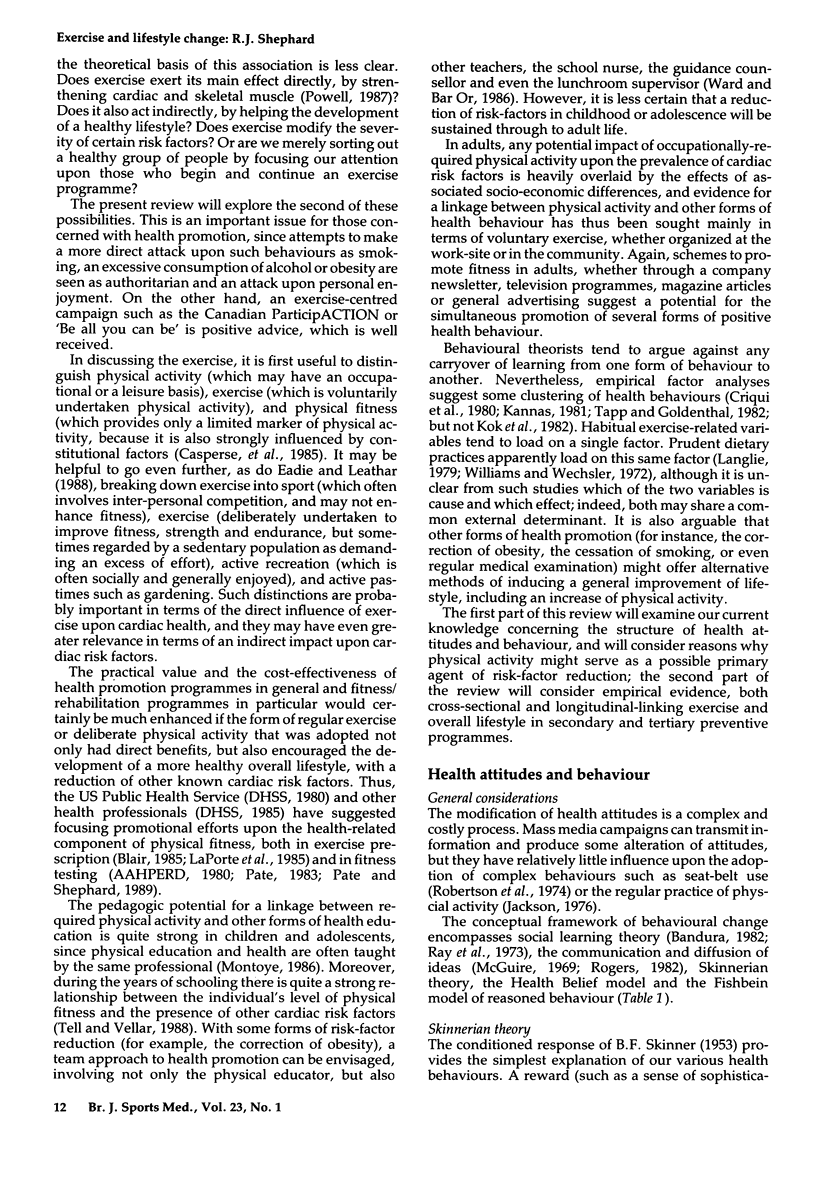
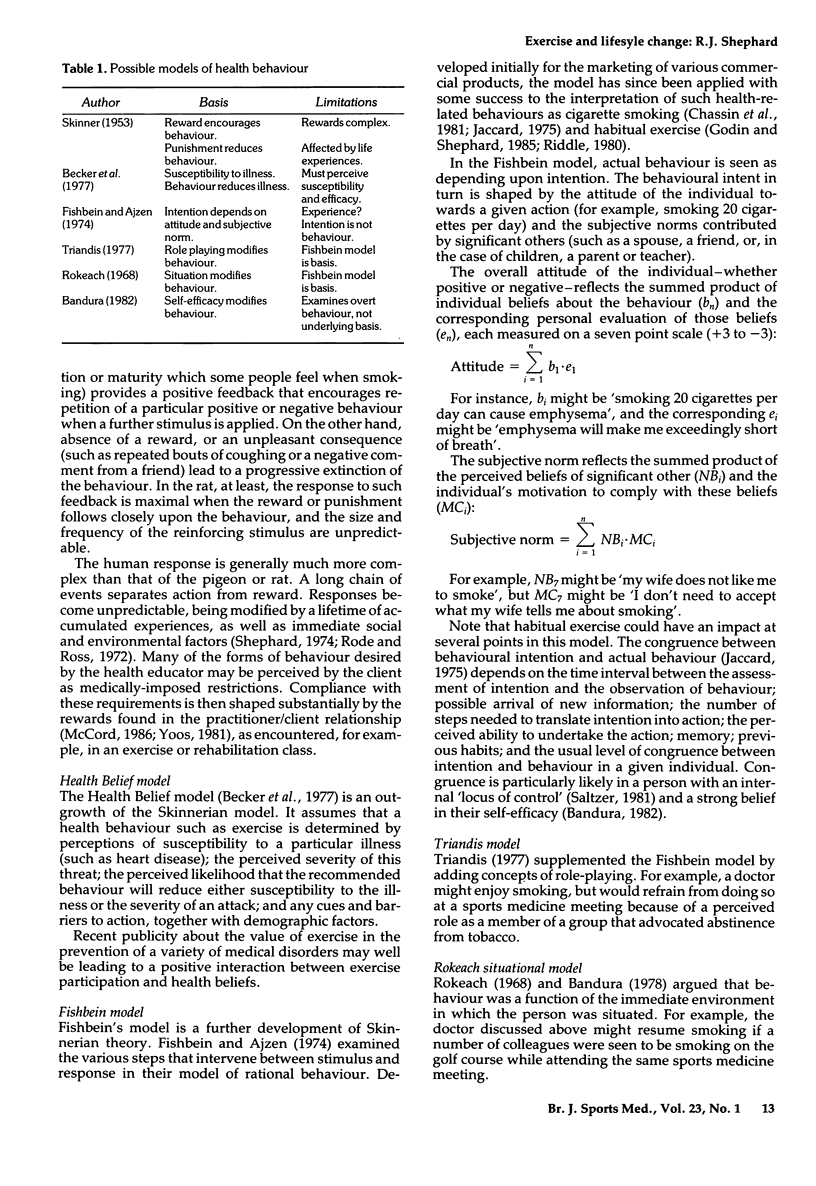


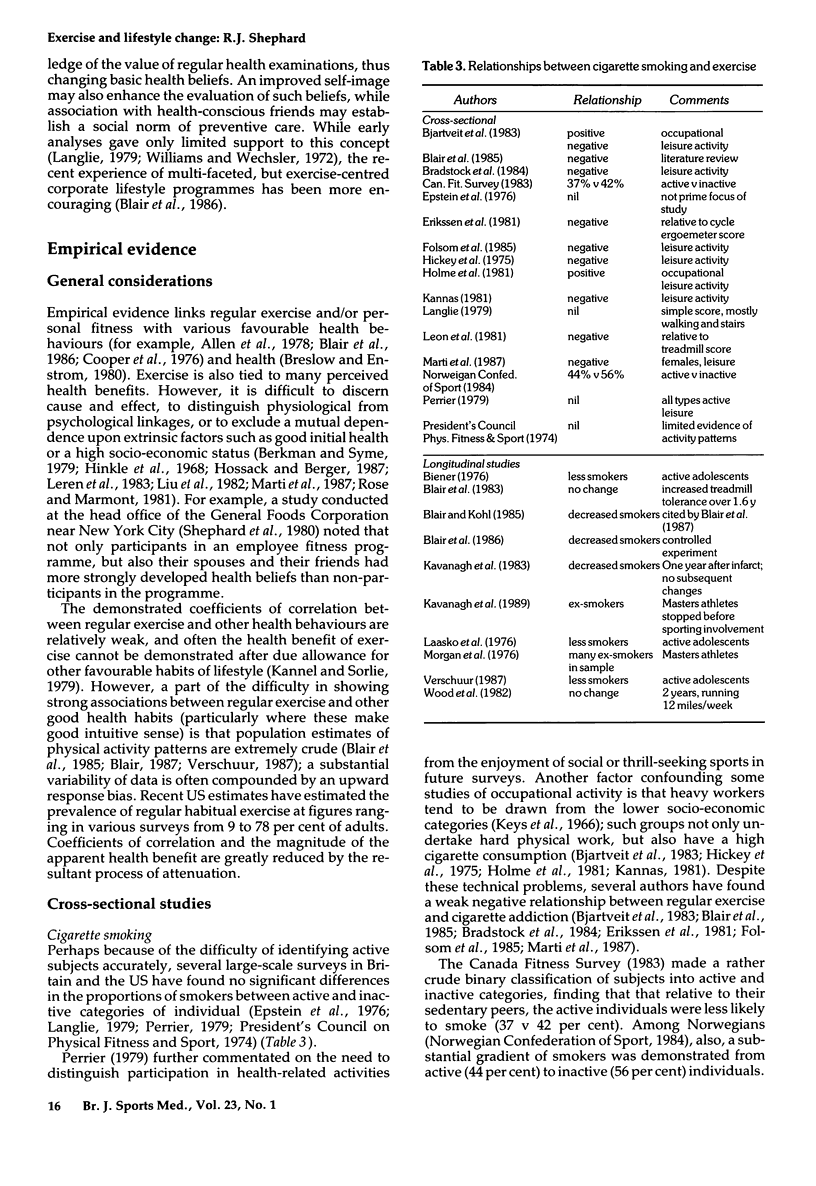

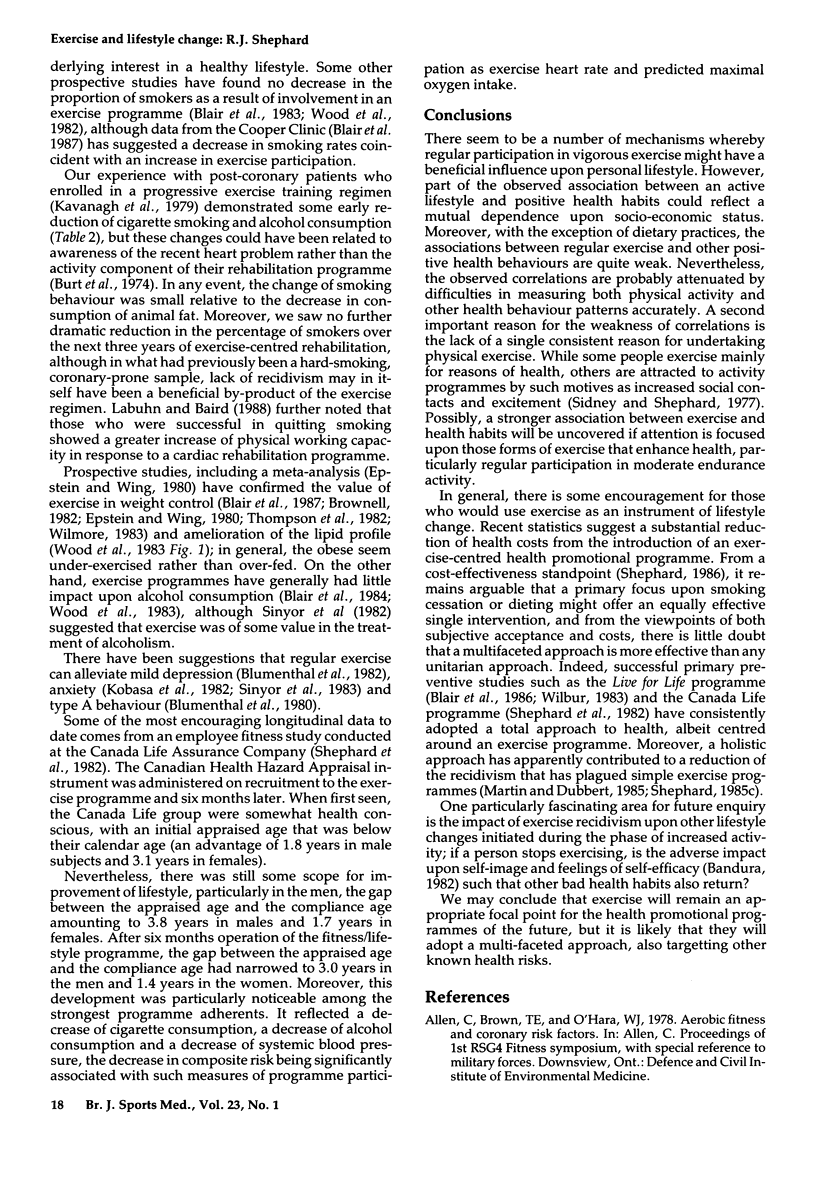


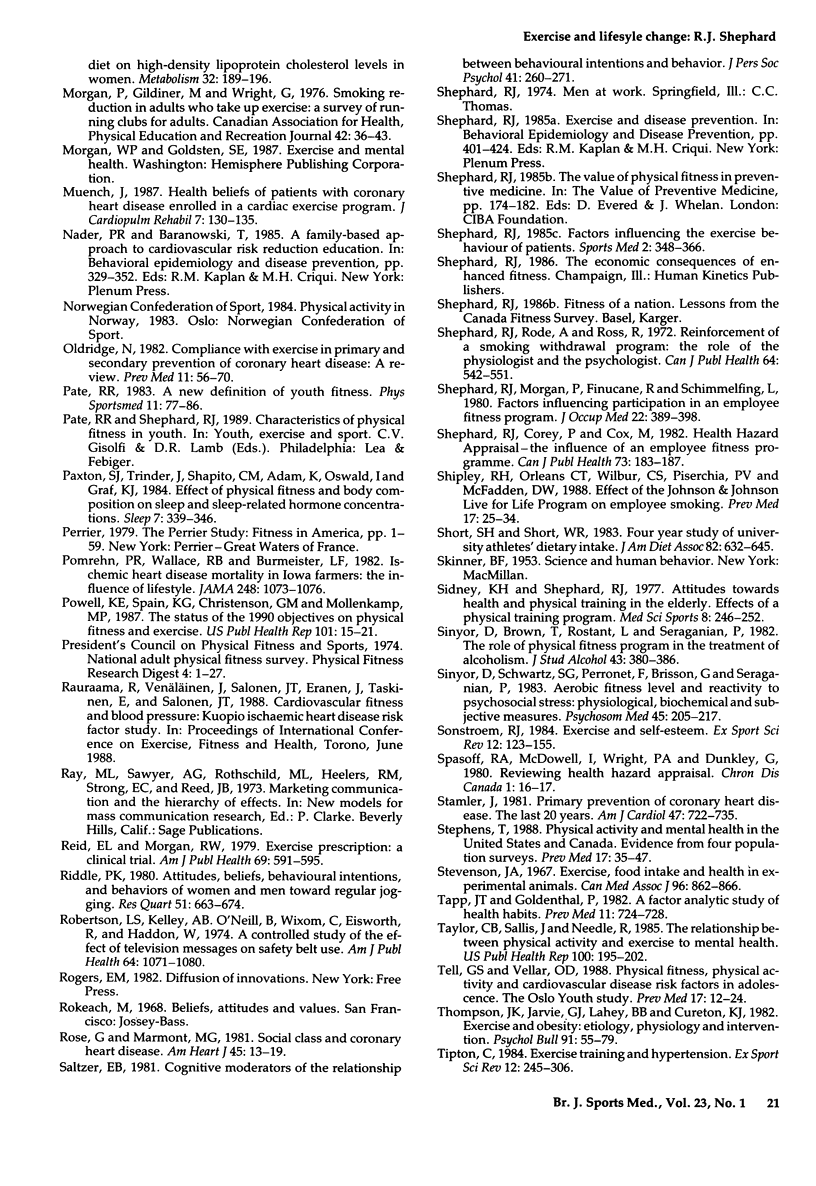
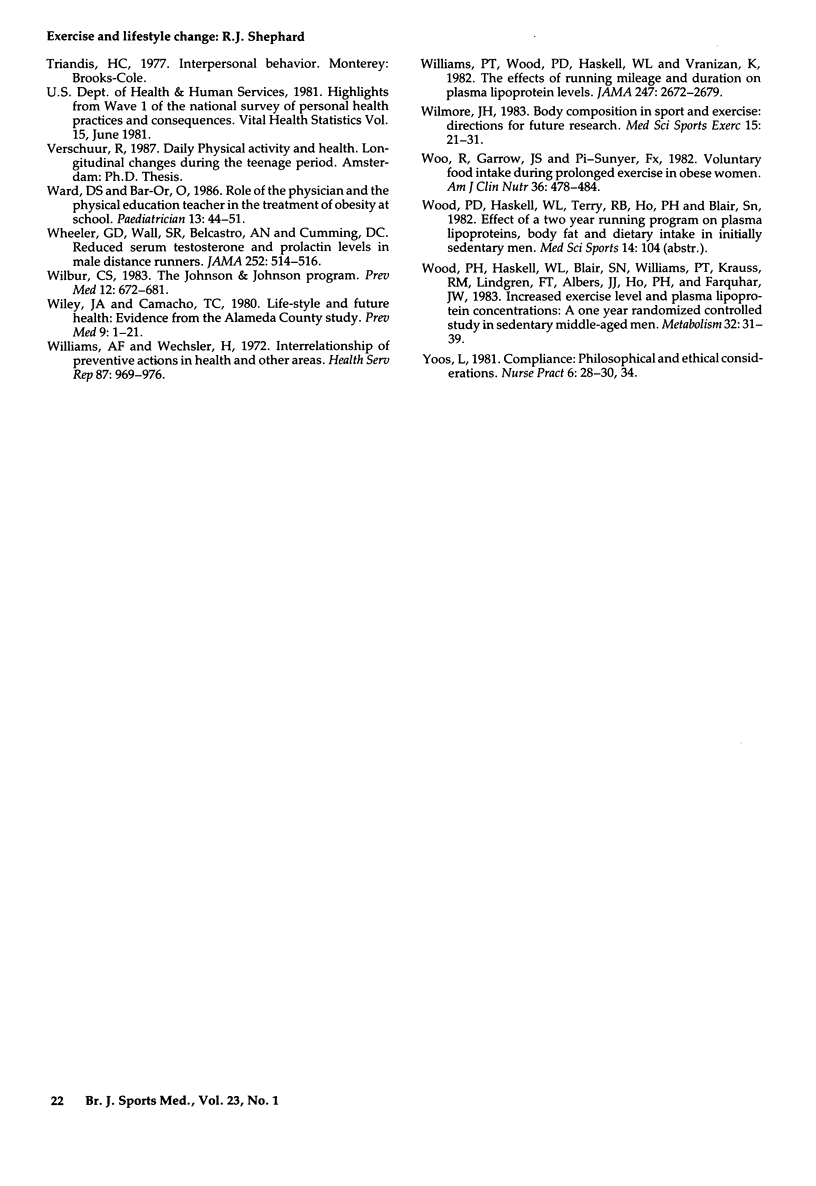
Images in this article
Selected References
These references are in PubMed. This may not be the complete list of references from this article.
- BULLEN B. A., REED R. B., MAYER J. PHYSICAL ACTIVITY OF OBESE AND NONOBESE ADOLESCENT GIRLS APPRAISED BY MOTION PICTURE SAMPLING. Am J Clin Nutr. 1964 Apr;14:211–223. doi: 10.1093/ajcn/14.4.211. [DOI] [PubMed] [Google Scholar]
- Becker M. H., Haefner D. P., Kasl S. V., Kirscht J. P., Maiman L. A., Rosenstock I. M. Selected psychosocial models and correlates of individual health-related behaviors. Med Care. 1977 May;15(5 Suppl):27–46. doi: 10.1097/00005650-197705001-00005. [DOI] [PubMed] [Google Scholar]
- Belloc N. B., Breslow L. Relationship of physical health status and health practices. Prev Med. 1972 Aug;1(3):409–421. doi: 10.1016/0091-7435(72)90014-x. [DOI] [PubMed] [Google Scholar]
- Berkman L. F., Syme S. L. Social networks, host resistance, and mortality: a nine-year follow-up study of Alameda County residents. Am J Epidemiol. 1979 Feb;109(2):186–204. doi: 10.1093/oxfordjournals.aje.a112674. [DOI] [PubMed] [Google Scholar]
- Biener K. Tabakkonsum and Sportverhaltung Jugendlicher. Schweiz Rundsch Med Prax. 1976 Jan 20;65(3):78–81. [PubMed] [Google Scholar]
- Blair S. N., Cooper K. H., Gibbons L. W., Gettman L. R., Lewis S., Goodyear N. Changes in coronary heart disease risk factors associated with increased treadmill time in 753 men. Am J Epidemiol. 1983 Sep;118(3):352–359. doi: 10.1093/oxfordjournals.aje.a113642. [DOI] [PubMed] [Google Scholar]
- Blair S. N., Ellsworth N. M., Haskell W. L., Stern M. P., Farquhar J. W., Wood P. D. Comparison of nutrient intake in middle-aged men and women runners and controls. Med Sci Sports Exerc. 1981;13(5):310–315. [PubMed] [Google Scholar]
- Blair S. N., Goodyear N. N., Wynne K. L., Saunders R. P. Comparison of dietary and smoking habit changes in physical fitness improvers and nonimprovers. Prev Med. 1984 Jul;13(4):411–420. doi: 10.1016/0091-7435(84)90032-x. [DOI] [PubMed] [Google Scholar]
- Blair S. N., Jacobs D. R., Jr, Powell K. E. Relationships between exercise or physical activity and other health behaviors. Public Health Rep. 1985 Mar-Apr;100(2):172–180. [PMC free article] [PubMed] [Google Scholar]
- Blair S. N., Piserchia P. V., Wilbur C. S., Crowder J. H. A public health intervention model for work-site health promotion. Impact on exercise and physical fitness in a health promotion plan after 24 months. JAMA. 1986 Feb 21;255(7):921–926. [PubMed] [Google Scholar]
- Blumenthal J. A., Williams R. S., Needels T. L., Wallace A. G. Psychological changes accompany aerobic exercise in healthy middle-aged adults. Psychosom Med. 1982 Dec;44(6):529–536. doi: 10.1097/00006842-198212000-00004. [DOI] [PubMed] [Google Scholar]
- Blumenthal J. A., Williams R. S., Williams R. B., Jr, Wallace A. G. Effects of exercise on the Type A (coronary prone) behavior pattern. Psychosom Med. 1980 Mar;42(2):289–296. doi: 10.1097/00006842-198003000-00006. [DOI] [PubMed] [Google Scholar]
- Breslow L., Enstrom J. E. Persistence of health habits and their relationship to mortality. Prev Med. 1980 Jul;9(4):469–483. doi: 10.1016/0091-7435(80)90042-0. [DOI] [PubMed] [Google Scholar]
- Brownell K. D. Obesity: understanding and treating a serious, prevalent, and refractory disorder. J Consult Clin Psychol. 1982 Dec;50(6):820–840. doi: 10.1037//0022-006x.50.6.820. [DOI] [PubMed] [Google Scholar]
- Burt A., Thornley P., Illingworth D., White P., Shaw T. R., Turner R. Stopping smoking after myocardial infarction. Lancet. 1974 Feb 23;1(7852):304–306. doi: 10.1016/s0140-6736(74)92607-5. [DOI] [PubMed] [Google Scholar]
- Caspersen C. J., Powell K. E., Christenson G. M. Physical activity, exercise, and physical fitness: definitions and distinctions for health-related research. Public Health Rep. 1985 Mar-Apr;100(2):126–131. [PMC free article] [PubMed] [Google Scholar]
- Chassin L., Presson C. C., Bensenberg M., Corty E., Olshavsky R. W., Sherman S. J. Predicting adolescents' intentions to smoke cigarettes. J Health Soc Behav. 1981 Dec;22(4):445–455. [PubMed] [Google Scholar]
- Cooper K. H., Pollock M. L., Martin R. P., White S. R., Linnerud A. C., Jackson A. Physical fitness levels vs selected coronary risk factors. A cross-sectional study. JAMA. 1976 Jul 12;236(2):166–169. [PubMed] [Google Scholar]
- Criqui M. H., Barrett-Connor E., Holdbrook M. J., Austin M., Turner J. D. Clustering of cardiovascular disease risk factors. Prev Med. 1980 Jul;9(4):525–533. doi: 10.1016/0091-7435(80)90047-x. [DOI] [PubMed] [Google Scholar]
- Durrant M. L., Royston J. P., Wloch R. T. Effect of exercise on energy intake and eating patterns in lean and obese humans. Physiol Behav. 1982 Sep;29(3):449–454. doi: 10.1016/0031-9384(82)90265-7. [DOI] [PubMed] [Google Scholar]
- Epstein L. H., Wing R. R. Aerobic exercise and weight. Addict Behav. 1980;5(4):371–388. doi: 10.1016/0306-4603(80)90011-8. [DOI] [PubMed] [Google Scholar]
- Epstein L., Miller G. J., Stitt F. W., Morris J. N. Vigorous exercise in leisure time, coronary risk-factors, and resting electrocardiogram in middle-aged male civil servants. Br Heart J. 1976 Apr;38(4):403–409. doi: 10.1136/hrt.38.4.403. [DOI] [PMC free article] [PubMed] [Google Scholar]
- Erikssen J., Forfang K., Jervell J. Coronary risk factors and physical fitness in healthy middle-aged men. Acta Med Scand Suppl. 1981;645:57–64. doi: 10.1111/j.0954-6820.1981.tb02601.x. [DOI] [PubMed] [Google Scholar]
- Folsom A. R., Caspersen C. J., Taylor H. L., Jacobs D. R., Jr, Luepker R. V., Gomez-Marin O., Gillum R. F., Blackburn H. Leisure time physical activity and its relationship to coronary risk factors in a population-based sample. The Minnesota Heart Survey. Am J Epidemiol. 1985 Apr;121(4):570–579. doi: 10.1093/oxfordjournals.aje.a114035. [DOI] [PubMed] [Google Scholar]
- Godin G., Cox M. H., Shephard R. J. The impact of physical fitness evaluation on behavioural intentions towards regular exercise. Can J Appl Sport Sci. 1983 Dec;8(4):240–245. [PubMed] [Google Scholar]
- Godin G., Shephard R. J. Physical fitness--individual or societal responsibility? Can J Public Health. 1984 May-Jun;75(3):200–203. [PubMed] [Google Scholar]
- Godin G., Valois P., Shephard R. J., Desharnais R. Prediction of leisure-time exercise behavior: a path analysis (LISREL V) model. J Behav Med. 1987 Apr;10(2):145–158. doi: 10.1007/BF00846423. [DOI] [PubMed] [Google Scholar]
- Gorsky R. D., Calloway D. H. Activity pattern changes with decreases in food energy intake. Hum Biol. 1983 Sep;55(3):577–586. [PubMed] [Google Scholar]
- Hickey N., Mulcahy R., Bourke G. J., Graham I., Wilson-Davis K. Study of coronary risk factors related to physical activity in 15 171 men. Br Med J. 1975 Aug 30;3(5982):507–509. doi: 10.1136/bmj.3.5982.507. [DOI] [PMC free article] [PubMed] [Google Scholar]
- Hinkle L. E., Jr, Whitney L. H., Lehman E. W., Dunn J., Benjamin B., King R., Plakun A., Flehinger B. Occupation, education, and coronary heart disease. Risk is influenced more by education and background than by occupational experiences, in the Bell System. Science. 1968 Jul 19;161(3838):238–246. doi: 10.1126/science.161.3838.238. [DOI] [PubMed] [Google Scholar]
- Holme I., Helgeland A., Hjermann I., Leren P., Lund-Larsen P. G. Physical activity at work and at leisure in relation to coronary risk factors and social class. A 4-year mortality follow-up. The Oslo study. Acta Med Scand. 1981;209(4):277–283. doi: 10.1111/j.0954-6820.1981.tb11591.x. [DOI] [PubMed] [Google Scholar]
- Jaccard J. A theoretical analysis of selected factors important to health education strategies. Health Educ Monogr. 1975 Summer;3(2):152–167. doi: 10.1177/109019817500300201. [DOI] [PubMed] [Google Scholar]
- Kannel W. B., Sorlie P. Some health benefits of physical activity. The Framingham Study. Arch Intern Med. 1979 Aug;139(8):857–861. [PubMed] [Google Scholar]
- Kavanagh T., Shephard R. J., Chisholm A. W., Qureshi S., Kennedy J. Prognostic indexes for patients with ischemic heart disease enrolled in an exercise-centered rehabilitation program. Am J Cardiol. 1979 Dec;44(7):1230–1240. doi: 10.1016/0002-9149(79)90434-x. [DOI] [PubMed] [Google Scholar]
- Kavanagh T., Shephard R. J., Lindley L. J., Pieper M. Influence of exercise and life-style variables upon high density lipoprotein cholesterol after myocardial infarction. Arteriosclerosis. 1983 May-Jun;3(3):249–259. doi: 10.1161/01.atv.3.3.249. [DOI] [PubMed] [Google Scholar]
- Kobasa S. C., Maddi S. R., Puccetti M. C. Personality and exercise as buffers in the stress-illness relationship. J Behav Med. 1982 Dec;5(4):391–404. doi: 10.1007/BF00845369. [DOI] [PubMed] [Google Scholar]
- Kok F. J., Matroos A. W., van den Ban A. W., Hautvast J. G. Characteristics of individuals with multiple behavioral risk factors for coronary heart disease: the Netherlands. Am J Public Health. 1982 Sep;72(9):986–991. doi: 10.2105/ajph.72.9.986. [DOI] [PMC free article] [PubMed] [Google Scholar]
- Kristein M. M. Economic issues in prevention. Prev Med. 1977 Jun;6(2):252–264. doi: 10.1016/0091-7435(77)90052-4. [DOI] [PubMed] [Google Scholar]
- Landry F., Leblanc C., Gaudreau J., Moisan A. Fitness and heath hazard indices: observations on their relationships as discriminant criteria. Can J Public Health. 1982 Jan-Feb;73(1):57–62. [PubMed] [Google Scholar]
- Langlie J. K. Interrelationships among preventive health behaviors: a test of competing hypotheses. Public Health Rep. 1979 Jun;94(3):216–225. [PMC free article] [PubMed] [Google Scholar]
- Leren P., Helgeland A., Hjermann I., Holme I. The Oslo study: CHD risk factors, socioeconomic influences, and intervention. Am Heart J. 1983 Nov;106(5 Pt 2):1200–1206. doi: 10.1016/0002-8703(83)90175-8. [DOI] [PubMed] [Google Scholar]
- Liu K., Cedres L. B., Stamler J., Dyer A., Stamler R., Nanas S., Berkson D. M., Paul O., Lepper M., Lindberg H. A. Relationship of education to major risk factors and death from coronary heart disease, cardiovascular diseases and all causes, Findings of three Chicago epidemiologic studies. Circulation. 1982 Dec;66(6):1308–1314. doi: 10.1161/01.cir.66.6.1308. [DOI] [PubMed] [Google Scholar]
- Marti B., Tuomilehto J., Salonen J. T., Puska P., Nissinen A. Relationship between leisure-time physical activity and risk factors for coronary heart disease in middle-aged Finnish women. Acta Med Scand. 1987;222(3):223–230. doi: 10.1111/j.0954-6820.1987.tb10663.x. [DOI] [PubMed] [Google Scholar]
- Martin J. E., Dubbert P. M. Adherence to exercise. Exerc Sport Sci Rev. 1985;13:137–167. [PubMed] [Google Scholar]
- Massie J. F., Shephard R. J. Physiological and psychological effects of training--a comparison of individual and gymnasium programs, with a characterization of the exercise "drop-out". Med Sci Sports. 1971 Fall;3(3):110–117. [PubMed] [Google Scholar]
- Mechanic D., Cleary P. D. Factors associated with the maintenance of positive health behavior. Prev Med. 1980 Nov;9(6):805–814. doi: 10.1016/0091-7435(80)90023-7. [DOI] [PubMed] [Google Scholar]
- Moore C. E., Hartung G. H., Mitchell R. E., Kappus C. M., Hinderlitter J. The relationship of exercise and diet on high-density lipoprotein cholesterol levels in women. Metabolism. 1983 Feb;32(2):189–196. doi: 10.1016/0026-0495(83)90228-7. [DOI] [PubMed] [Google Scholar]
- Oldridge N. B. Compliance and exercise in primary and secondary prevention of coronary heart disease: a review. Prev Med. 1982 Jan;11(1):56–70. doi: 10.1016/0091-7435(82)90005-6. [DOI] [PubMed] [Google Scholar]
- Paxton S. J., Trinder J., Shapiro C. M., Adam K., Oswald I., Gräf K. J. Effect of physical fitness and body composition on sleep and sleep-related hormone concentrations. Sleep. 1984;7(4):339–346. doi: 10.1093/sleep/7.4.339. [DOI] [PubMed] [Google Scholar]
- Pomrehn P. R., Wallace R. B., Burmeister L. F. Ischemic heart disease mortality in Iowa farmers. The influence of life-style. JAMA. 1982 Sep 3;248(9):1073–1076. [PubMed] [Google Scholar]
- Powell K. E., Spain K. G., Christenson G. M., Mollenkamp M. P. The status of the 1990 objectives for physical fitness and exercise. Public Health Rep. 1986 Jan-Feb;101(1):15–21. [PMC free article] [PubMed] [Google Scholar]
- Reid E. L., Morgan R. W. Exercise prescription: a clinical trial. Am J Public Health. 1979 Jun;69(6):591–595. doi: 10.2105/ajph.69.6.591. [DOI] [PMC free article] [PubMed] [Google Scholar]
- Riddle P. K. Attitudes, beliefs, behavioral intentions, and behaviors of women and men toward regular jogging. Res Q Exerc Sport. 1980 Dec;51(4):663–674. doi: 10.1080/02701367.1980.10609327. [DOI] [PubMed] [Google Scholar]
- Robertson L. S., Kelley A. B., O'Neill B., Wixom C. W., Eiswirth R. S., Haddon W., Jr A controlled study of the effect of television messages on safety belt use. Am J Public Health. 1974 Nov;64(11):1071–1080. doi: 10.2105/ajph.64.11.1071. [DOI] [PMC free article] [PubMed] [Google Scholar]
- Rose G., Marmot M. G. Social class and coronary heart disease. Br Heart J. 1981 Jan;45(1):13–19. doi: 10.1136/hrt.45.1.13. [DOI] [PMC free article] [PubMed] [Google Scholar]
- Shephard R. J., Corey P., Cox M. Health hazard appraisal--the influence of an employee fitness program. Can J Public Health. 1982 May-Jun;73(3):183–187. [PubMed] [Google Scholar]
- Shephard R. J. Factors influencing the exercise behaviour of patients. Sports Med. 1985 Sep-Oct;2(5):348–366. doi: 10.2165/00007256-198502050-00004. [DOI] [PubMed] [Google Scholar]
- Shephard R. J., Morgan P., Finucane R., Schimmelfing L. Factors influencing recruitment to an occupational fitness program. J Occup Med. 1980 Jun;22(6):389–398. [PubMed] [Google Scholar]
- Shipley R. H., Orleans C. T., Wilbur C. S., Piserchia P. V., McFadden D. W. Effect of the Johnson & Johnson Live for Life program on employee smoking. Prev Med. 1988 Jan;17(1):25–34. doi: 10.1016/0091-7435(88)90069-2. [DOI] [PubMed] [Google Scholar]
- Short S. H., Short W. R. Four-year study of university athletes' dietary intake. J Am Diet Assoc. 1983 Jun;82(6):632–645. [PubMed] [Google Scholar]
- Sidney K. H., Shephard R. J. Attitudes towards health and physical activity in the elderly. Effects of a physical training program. Med Sci Sports. 1976 Winter;8(4):246–252. [PubMed] [Google Scholar]
- Sinyor D., Brown T., Rostant L., Seraganian P. The role of a physical fitness program in the treatment of alcoholism. J Stud Alcohol. 1982 Mar;43(3):380–386. doi: 10.15288/jsa.1982.43.380. [DOI] [PubMed] [Google Scholar]
- Sinyor D., Schwartz S. G., Peronnet F., Brisson G., Seraganian P. Aerobic fitness level and reactivity to psychosocial stress: physiological, biochemical, and subjective measures. Psychosom Med. 1983 Jun;45(3):205–217. doi: 10.1097/00006842-198306000-00003. [DOI] [PubMed] [Google Scholar]
- Sonstroem R. J. Exercise and self-esteem. Exerc Sport Sci Rev. 1984;12:123–155. [PubMed] [Google Scholar]
- Stamler J. Primary prevention of coronary heart disease: the last 20 years. Am J Cardiol. 1981 Mar;47(3):722–735. [PubMed] [Google Scholar]
- Stephens T. Physical activity and mental health in the United States and Canada: evidence from four population surveys. Prev Med. 1988 Jan;17(1):35–47. doi: 10.1016/0091-7435(88)90070-9. [DOI] [PubMed] [Google Scholar]
- Stevenson J. A. Exercise, food intake and health in experimental animals. Can Med Assoc J. 1967 Mar 25;96(12):862–867. [PMC free article] [PubMed] [Google Scholar]
- Tapp J. T., Goldenthal P. A factor analytic study of health habits. Prev Med. 1982 Nov;11(6):724–728. doi: 10.1016/0091-7435(82)90035-4. [DOI] [PubMed] [Google Scholar]
- Taylor C. B., Sallis J. F., Needle R. The relation of physical activity and exercise to mental health. Public Health Rep. 1985 Mar-Apr;100(2):195–202. [PMC free article] [PubMed] [Google Scholar]
- Tell G. S., Vellar O. D. Physical fitness, physical activity, and cardiovascular disease risk factors in adolescents: the Oslo Youth Study. Prev Med. 1988 Jan;17(1):12–24. doi: 10.1016/0091-7435(88)90068-0. [DOI] [PubMed] [Google Scholar]
- Thompson J. K., Jarvie G. J., Lahey B. B., Cureton K. J. Exercise and obesity: etiology, physiology, and intervention. Psychol Bull. 1982 Jan;91(1):55–79. [PubMed] [Google Scholar]
- Tipton C. M. Exercise, training, and hypertension. Exerc Sport Sci Rev. 1984;12:245–306. [PubMed] [Google Scholar]
- Ward D. S., Bar-Or O. Role of the physician and physical education teacher in the treatment of obesity at school. Pediatrician. 1986;13(1):44–51. [PubMed] [Google Scholar]
- Wheeler G. D., Wall S. R., Belcastro A. N., Cumming D. C. Reduced serum testosterone and prolactin levels in male distance runners. JAMA. 1984 Jul 27;252(4):514–516. [PubMed] [Google Scholar]
- Wilbur C. S. The Johnson & Johnson program. Prev Med. 1983 Sep;12(5):672–681. doi: 10.1016/0091-7435(83)90225-6. [DOI] [PubMed] [Google Scholar]
- Wiley J. A., Camacho T. C. Life-style and future health: evidence from the Alameda County study. Prev Med. 1980 Jan;9(1):1–21. doi: 10.1016/0091-7435(80)90056-0. [DOI] [PubMed] [Google Scholar]
- Williams A. F., Wechsler H. Interrelationship of preventive actions in health and other areas. Health Serv Rep. 1972 Dec;87(10):969–976. [PMC free article] [PubMed] [Google Scholar]
- Williams P. T., Wood P. D., Haskell W. L., Vranizan K. The effects of running mileage and duration on plasma lipoprotein levels. JAMA. 1982 May 21;247(19):2674–2679. [PubMed] [Google Scholar]
- Wilmore J. H. Body composition in sport and exercise: directions for future research. Med Sci Sports Exerc. 1983;15(1):21–31. [PubMed] [Google Scholar]
- Woo R., Garrow J. S., Pi-Sunyer F. X. Voluntary food intake during prolonged exercise in obese women. Am J Clin Nutr. 1982 Sep;36(3):478–484. doi: 10.1093/ajcn/36.3.478. [DOI] [PubMed] [Google Scholar]
- Wood P. D., Haskell W. L., Blair S. N., Williams P. T., Krauss R. M., Lindgren F. T., Albers J. J., Ho P. H., Farquhar J. W. Increased exercise level and plasma lipoprotein concentrations: a one-year, randomized, controlled study in sedentary, middle-aged men. Metabolism. 1983 Jan;32(1):31–39. doi: 10.1016/0026-0495(83)90152-x. [DOI] [PubMed] [Google Scholar]
- Yoos L. Compliance: philosophical and ethical considerations. Nurse Pract. 1981 Sep-Oct;6(5):27-30, 34. [PubMed] [Google Scholar]



